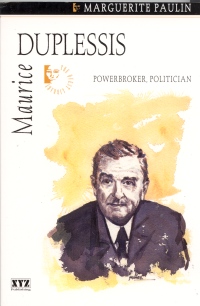| ________________
CM . . .
. Volume XII Number 10 . . . .January 20, 2006
excerpt:
Paulin, a radio host and producer in Montreal, biographer and lecturer at McGill University, relies upon secondary sources to construct this biography of the controversial figure who was the longest-governing premier in Quebec’s history. Paulin strives to be non-partisan but casts a critical eye upon Duplessis’s methods that included extensive use of patronage and envelopes of cash for journalists who wrote favourable copy. Maurice Duplessis was born in 1890 into a political family in Trois-Rivières. His father, Nérée, was a Conservative member of the Quebec Legislative Assembly for 14 years and later became a judge. Maurice was sent to boarding school in Montreal and went on to law school at the Université de Laval where he impressed his classmates with his oratorical skills. He continued to hone these skills after opening a law practice in his hometown. His first foray before the electorate ended in defeat in 1923, but at the age of 37, he was elected in 1927 as the member for Trois-Rivières, a position that he held until his death in office in 1959. Paulin makes extensive use of imagined dialogue as well as an authoritative narrative voice to tell the story of Duplessis’s political and private life. She makes many references to contemporary Quebec society in order to capture the flavour of the time. The occasional footnote is used to explain a term or short form that may be unfamiliar to modern, especially non-Quebec readers. Many other mysteries remain unexplained such as the laws that permitted Duplessis’s rival, Montreal mayor Camillien Houde, to hold the mayoralty and a seat in the Legislative Assembly simultaneously and then to run in two ridings in the 1931 election. Much of the text deals with the Machiavellian world of politics. Duplessis shored up support amongst his constituents and the Catholic Church while pursuing political power. He became leader of the Québec Conservative Party in 1933 but prudently formed an unlikely alliance with members of the reform-minded Action Libérale Nationale to create a new party, the Union Nationale, shortly before an election in 1935. Although still in opposition, Duplessis exposed corruption in the entrenched Liberal government of the day and swept into power in 1936. He also managed to sweep his former allies from the Action Libérale Nationale to the periphery or out of the new party entirely. His government proved to be short-lived, going down to defeat in 1939. When the Union Nationale formed the new government in 1944, Premier Duplessis was also something of a new man. Formerly a heavy drinker and smoker, health problems including diabetes had forced him to stop drinking alcohol. Unfortunately, Duplessis’s second, 15-year term as premier, that included re-elections in 1948, 1952, and 1956, receives relatively little coverage in Paulin’s biography, accounting for only one fourth of the text. Nevertheless, she manages to highlight many of the controversies and achievements of the Duplessis regime, including its use of the Padlock Laws to suppress communists, persecution of the Jehovah’s Witnesses, the adoption of the Fleur-de-lis as provincial flag, and the use of the provincial police to crush the strike in the town of Asbestos in 1949. Duplessis’s use or abuse of power at Asbestos and elsewhere encouraged activists like Gérard Pelletier and Pierre Elliot Trudeau to speak out in defense of civil liberties. The Asbestos strike also marked a growing rift between Duplessis and the Catholic Church, as the archbishop of Montreal supported the workers. Was Monsignor Charbonneau’s resignation shortly afterward due to Duplessis’s influence? Recommended with reservations. Val Ken Lem is a catalogue librarian and member of the Collection Services Team at Ryerson University in Toronto, ON.
To comment
on this title or this review, send mail to cm@umanitoba.ca.
Copyright © the Manitoba Library Association. Reproduction for personal
use is permitted only if this copyright notice is maintained. Any
other reproduction is prohibited without permission.
NEXT REVIEW |
TABLE OF CONTENTS FOR THIS ISSUE
- January 20, 2006.
AUTHORS |
TITLES |
MEDIA REVIEWS |
PROFILES |
BACK ISSUES |
SEARCH |
CMARCHIVE |
HOME |
